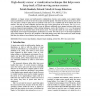Free Online Productivity Tools
i2Speak
i2Symbol
i2OCR
iTex2Img
iWeb2Print
iWeb2Shot
i2Type
iPdf2Split
iPdf2Merge
i2Bopomofo
i2Arabic
i2Style
i2Image
i2PDF
iLatex2Rtf
Sci2ools
INTERACT
2003
2003
High-Density Cursor: a Visualization Technique that Helps Users Keep Track of Fast-moving Mouse Cursors
: As bigger screens and multi-monitor configurations become more popular, users employ higher mouse accelerations in order to traverse the screen reasonably quickly. The faster the mouse cursor moves, however, the more it seems to jump from one position to the next, as it is updated only at the refresh rate of the monitor. This lack of visual continuity increases the risk of users losing track of the cursor. The high-density cursor presented in this paper addresses this issue by filling in additional cursor images between actual cursor positions (temporal supersampling). Unlike existing techniques, such as the Windows mouse trail, the proposed technique preserves the responsiveness of the mouse cursor. We report the results of a user study in which the high-density cursor improved participants’ performance on a Fitts’ law task by up to 7% for target acquisitions across long distances. Moreover, the conditions of the high-density mouse that were tested were subtle enough that they w...
| Added | 31 Oct 2010 |
| Updated | 31 Oct 2010 |
| Type | Conference |
| Year | 2003 |
| Where | INTERACT |
| Authors | Patrick Baudisch, Edward Cutrell, George G. Robertson |
Comments (0)

